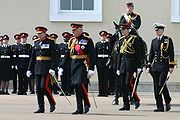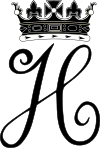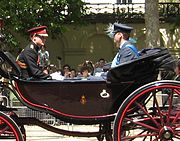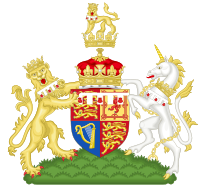
Prince Harry of Wales
Did you know...
The articles in this Schools selection have been arranged by curriculum topic thanks to SOS Children volunteers. SOS Children has looked after children in Africa for forty years. Can you help their work in Africa?
| Prince Harry | |
|---|---|
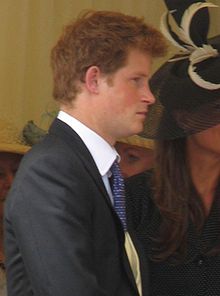 |
|
| Full name | |
| Henry Charles Albert David | |
| House | House of Windsor |
| Father | Charles, Prince of Wales |
| Mother | Diana, Princess of Wales |
Prince Henry Charles Albert David of Wales (born 15 September 1984), commonly known as Prince Harry, is the younger son of Charles, Prince of Wales and the late Diana, Princess of Wales, and grandson of Queen Elizabeth II. As such, he is third in the line of succession to the thrones of 16 independent countries, though he is resident in and most directly involved with the United Kingdom.
After an education at various schools around the United Kingdom and spending parts of his gap year in Australia and Lesotho, Harry, unlike his elder brother, Prince William, eschewed a university education in favour of following in the footsteps of various royal men by enrolling in the military. He was commissioned as a second lieutenant into the Blues and Royals of the Household Cavalry Regiment– serving temporarily with his brother– and completed his training as a tank commander. He served for 77 days on the front line in the Afghan War, although he was pulled out following publication of the story in an Australian magazine.
Early life
| The Royal Family of the United Kingdom and the other Commonwealth realms |
|---|
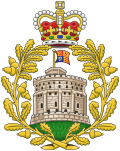 |
|
HM The Queen
|
Harry was born at St Mary's Hospital in Paddington, London, England, on 15 September 1984, weighing 6 lb 15oz. The second child of Prince Charles, and the late Diana, Princess of Wales, younger brother of Prince William, and fourth grandchild of Queen Elizabeth II and Prince Philip, Duke of Edinburgh. On 21 December 1984, he was baptised at St George's Chapel, in Windsor Castle, by then Archbishop of Canterbury, Robert Runcie, Harry's godparents were: the Prince Andrew (his paternal uncle); the Lady Sarah Armstrong-Jones (his paternal cousin); the Lady Vestey; Mrs William Bartholomew; Bryan Organ; and Gerald Ward.
Diana wanted William and Harry to have a broader range of experiences than previous royal children and took both to venues that ranged from Disney World and McDonald's to AIDS clinics and shelters for the homeless. Diana, Princess of Wales, who was by then divorced from the Prince of Wales, died in a car accident in 1997. Harry, his brother and their father were staying at Balmoral Castle at the time, and the Prince of Wales waited until early the following morning to tell his sons about their mother's death. At his mother's funeral, Harry accompanied his father, brother, paternal grandfather, and maternal uncle in walking behind the funeral cortège from Kensington Palace to Westminster Abbey.
Education
Like his father and elder brother, Harry was educated at independent schools, starting at Jane Mynors' nursery school and the pre-preparatory Wetherby School, both in London. Following this, he attended Ludgrove School, and, after passing the entrance exams, was admitted to Eton College, where he studied geography, art history, and art at A-Level. The decision to place Harry in Eton went against the family tradition of sending royal children to Gordonstoun (Harry's grandfather, father, two uncles, and two cousins all attended); it did, however, make the Prince follow in the Spencer family footsteps, as both Diana's father and brother had attended Eton. In June 2003, he completed his education at Eton with two A-Levels, obtaining a B in art, and a D in geography, having decided to drop history of art after AS level. He excelled in sports, however, developing his love for sports, particularly polo and rugby union.
After graduation, the Prince took a gap year, during which he spent time in Australia, working (as his father had done in his youth) on a cattle station and participating in the Young England vs Young Australia Polo Test Match. He also travelled to Lesotho, where he worked with orphaned children and produced the documentary film The Forgotten Kingdom, and holidayed in Argentina.
Royal duties and career
Prince Harry began to accompany his parents on official visits at an early age; his first overseas royal tour was with his parents to Italy in 1985. The earlier decision made by the Princess of Wales to take an infant William to Australia set the precedent for young royal children going on official visits. Harry then accompanied either both parents or his father on subsequent tours, though he did not begin solo official engagements until after his military training and active service; In August 1995, at the age of 10, Prince Harry attended the 50th anniversary of Victory over Japan Day at the Cenotaph in London, there he saluted the officers in the military parade, one of the most important ceremonies in the royal family agenda; in 2008, he began to undertake royal visits to schools and organisations in Wales.
Military career
Prince Harry entered the Royal Military Academy Sandhurst on 8 May 2005, where he was known as Officer Cadet Wales, and joined the Alamein Company. Within a year, in April 2006, Harry completed his officer's training and was commissioned as a Cornet in the Blues and Royals, a regiment of the Household Cavalry in the British Army. By April 2008, whereupon he reached two years' seniority, Harry was promoted to the rank of lieutenant.
The British Ministry of Defence and Clarence House made a joint announcement on 22 February 2007 that Prince Harry would be deployed with his regiment to the front line in Iraq, to serve as part of the 1st Mechanised Brigade of the 3rd Mechanised Division–a move supported by Harry, who had stated that he would leave the army if he was told to remain in safety while his regiment went to war Then head of the British army, General Sir Richard Dannatt, first said on 30 April 2007 that he had personally decided that the Prince would serve with his unit in Iraq, and Harry was scheduled for deployment in May or June 2007, to patrol the Maysan province. By 16 May, however, Dannatt announced that Prince Harry would not serve in Iraq; concerns included Harry being a high-value target (as several threats by various groups have already been made against him) and the dangers the soldiers around him would face should any attempt be made on the Prince's life or capture. Clarence House made public the Prince's disappointment with the decision, though he said he would abide by it. In May 2007, British soldiers in Iraq were reported to be wearing t-shirts bearing the statement "I'm Harry!"; a reference to the scene in the movie Spartacus in which the survivors of Spartacus's army, defeated by Roman legions, are offered leniency by Crassus if they will identify their leader. Every survivor declares: "I'm Spartacus!"
It was reported in early June 2007 that Prince Harry had arrived in Canada to train, alongside other soldiers of the Canadian Forces and British Army, at CFB Suffield near Medicine Hat, Alberta. It was said that this was in preparation for a tour of duty in Afghanistan, where Canadian and British forces were participating in the NATO led Afghan War; rumours that were confirmed in February the following year, when the British Ministry of Defence revealed that Harry had secretly been deployed as a Forward Air Controller to Helmand Province in the Asian country. The revelation came after the media–notably, the German newspaper Bild and Australian magazine New Idea– breached the blackout placed over the information by the Canadian and British authorities. It was later reported that, while in Afghanistan, Harry had called in United States Air Force air strikes, helped Gurkha troops repel an attack from Taliban insurgents, and performed patrol duty in hostile areas. His tour came 735 years after his ancestor, Edward I of England (then Prince Edward), had also been on military duty in the Middle East during the Ninth crusade, and also made Harry the first member of the Royal Family to have served in a war zone since his uncle, Prince Andrew, Duke of York, flew helicopters during the Falklands War; at the time, Andrew was second in line to the thrones of the Commonwealth realms. For his service, Prince Harry was decorated with the Operational Service Medal for Afghanistan by his aunt, the Princess Royal, at the Combermere Barracks in May 2008.
In October 2008, the news was revealed that Prince Harry was to follow his brother, father, and uncle with the wish to fly military helicopters. After passing the initial aptitude test, he will undertake a month-long course; depending on whether or not he passes this course he may proceed onto full flight training in early 2009. Harry will need to pass his flying assessment at the Army Air Corps Base in Middle Wallop, the result of which will determine if he will pass on to train as a pilot of either the Apache, Lynx, or Gazelle helicopter.
Prince Harry was presented with his flying brevet (wings) by his father, the Prince of Wales, on 7 May 2010 at a ceremony at the Army Air Corps Base (AAC), Middle Wallop. Prince Harry has also let it be known that he intends to fly Apache attack helicopters if he is successful and passes the rigorous Apache training course at the AAC base Middle Wallop; after which time it may be possible for him to see active military service once again on the frontline in one of the warzones. During the ceremony, he switched his Blues and Royals' Officer's Service Dress cap for that of the Army Air Corps' sky blue beret with a Blues and Royals badge.
Royal duties
At the age of 23, Prince Harry was appointed as a Counsellor of State, and began his royal duties by first serving in that capacity when the Queen was abroad to attend the 2005 Commonwealth Heads of Government Meeting in Malta. The following year, Harry was in Lesotho to visit again Mants'ase Children's Home near Mohale's Hoek (which he first toured in 2004), and along with Prince Seeiso of Lesotho launched Sentebale: The Princes' Fund for Lesotho, a charity to aid children orphaned by HIV/AIDS. He has also granted his patronage to a number of other organisations, including WellChild, Dolen Cymru, and MapAction. To aid Sentebale, as well as the Diana, Princess of Wales Memorial Fund and Centrepoint, Harry and his brother organised the Concert for Diana at Wembley Stadium, on 1 July 2007.
Sports have also been a way that the Prince has helped charities and other organisations, such as when he trained as a Rugby Development Officer for the Rugby Football Union in 2004 and then coached students in schools in order to encourage them to learn the sport. He has also participated in polo matches, like his brother and father, in order to raise money for charitable causes.
On 6 January 2009, Harry and his brother Prince William were granted their own royal household by their grandmother, Queen Elizabeth II. It has three main staff members, supported by a "small" team. Sir David Manning, the former British ambassador to Washington, will work as a part-time adviser to the princes. Previously, William and Harry's affairs had been handled by the office of their father at Clarence House in central London. The brothers' new household released a statement– complete with their own cyphers at the top– announcing that they have established their own office at nearby St. James's Palace to look after their public, military, and charitable activities. Harry's cypher is similar to his brother's, but displays an H in a shade of blue similar to that used by his mother.
Titles, styles, honours, arms
Titles and styles
| Royal styles of HRH Prince Henry of Wales |
|
|---|---|
 |
|
| Reference style | His Royal Highness |
| Spoken style | Your Royal Highness |
| Alternative style | Sir |
- 15 September 1984–: His Royal Highness Prince Henry of Wales
The Prince's style and title in full: His Royal Highness Prince Henry Charles Albert David of Wales. As a British prince, Harry holds no surname; however, as with the other male-line grandchildren of Elizabeth II, he uses the name of the area over which his father holds title, i.e. Wales (as Princess Beatrice and Princess Eugenie use York, per their father, Prince Andrew, Duke of York). Past precedent is that such surnames are dropped from usage in adulthood, after which either title alone, or Mountbatten-Windsor is used when necessary. If his father or brother succeeds to the throne he will be known as His Royal Highness The Prince Henry.
As the second son of the heir apparent, Henry will most likely be given the title Duke of York at some point after the death of his uncle, Andrew who himself is the second son of the current monarch. However, such a transfer will not be automatic. As Andrew has two daughters and no sons, the dukedom of York will become extinct upon his death, and it will be up to the monarch reigning at the time to confer the title upon Henry.
Military ranks
- 13 April 2006– 13 April 2008: Cornet ( Second Lieutenant), The Blues and Royals
- 13 April 2008–: Lieutenant, The Blues and Royals
Honours
- Medals
 6 February 2002: Queen Elizabeth II Golden Jubilee Medal
6 February 2002: Queen Elizabeth II Golden Jubilee Medal 5 May 2008: Operational Service Medal for Afghanistan
5 May 2008: Operational Service Medal for Afghanistan
Honorary military appointments
 3 October 2008–: Honorary Air Commodore of RAF Wittering
3 October 2008–: Honorary Air Commodore of RAF Wittering 3 October 2008–: Honorary Air Commandant of RAF Honington
3 October 2008–: Honorary Air Commandant of RAF Honington 8 August 2006–: Commodore-in-Chief of Small Ships and Diving
8 August 2006–: Commodore-in-Chief of Small Ships and Diving
Arms
|
||||||||||||||||
Ancestry
| Ancestors of Prince Harry of Wales | ||||||||||||||||||||||||||||||||||||||||||||||||||||||||||||||||||||||||||||||||||||||||||||||||||||||||||||||||||||||||||||||||||||||||||||||||||||||||||||||||||||||||||||||||||||||||||||||||||||||||||||||||||||||||||||||||||||||||||||||||||||||||||||||||||||||||||||||||||||||||||||||||||||||||||||||||||||||||||||||||||||||||||||||||||||||||||||||||||||||||||||||||||||||||||||||||||||||||||||||||||||||||||||||||||||||||||||||||||||||||||||||||||||||||||||||||||||||||||||||||||||||||||||||||||||||||||||||||||||||||||||||||||||||||||||||||||
|---|---|---|---|---|---|---|---|---|---|---|---|---|---|---|---|---|---|---|---|---|---|---|---|---|---|---|---|---|---|---|---|---|---|---|---|---|---|---|---|---|---|---|---|---|---|---|---|---|---|---|---|---|---|---|---|---|---|---|---|---|---|---|---|---|---|---|---|---|---|---|---|---|---|---|---|---|---|---|---|---|---|---|---|---|---|---|---|---|---|---|---|---|---|---|---|---|---|---|---|---|---|---|---|---|---|---|---|---|---|---|---|---|---|---|---|---|---|---|---|---|---|---|---|---|---|---|---|---|---|---|---|---|---|---|---|---|---|---|---|---|---|---|---|---|---|---|---|---|---|---|---|---|---|---|---|---|---|---|---|---|---|---|---|---|---|---|---|---|---|---|---|---|---|---|---|---|---|---|---|---|---|---|---|---|---|---|---|---|---|---|---|---|---|---|---|---|---|---|---|---|---|---|---|---|---|---|---|---|---|---|---|---|---|---|---|---|---|---|---|---|---|---|---|---|---|---|---|---|---|---|---|---|---|---|---|---|---|---|---|---|---|---|---|---|---|---|---|---|---|---|---|---|---|---|---|---|---|---|---|---|---|---|---|---|---|---|---|---|---|---|---|---|---|---|---|---|---|---|---|---|---|---|---|---|---|---|---|---|---|---|---|---|---|---|---|---|---|---|---|---|---|---|---|---|---|---|---|---|---|---|---|---|---|---|---|---|---|---|---|---|---|---|---|---|---|---|---|---|---|---|---|---|---|---|---|---|---|---|---|---|---|---|---|---|---|---|---|---|---|---|---|---|---|---|---|---|---|---|---|---|---|---|---|---|---|---|---|---|---|---|---|---|---|---|---|---|---|---|---|---|---|---|---|---|---|---|---|---|---|---|---|---|---|---|---|---|---|---|---|---|---|---|---|---|---|---|---|---|---|---|---|---|---|---|---|---|---|---|---|---|---|---|---|---|---|---|---|---|---|---|---|---|---|---|---|---|---|---|---|---|---|---|---|---|---|---|---|---|---|---|---|---|---|---|---|---|---|---|---|---|---|---|---|---|---|---|---|---|---|---|---|---|---|---|---|---|---|---|---|---|---|---|---|---|---|---|---|---|---|---|---|---|---|---|---|---|---|---|---|---|---|---|---|---|---|---|---|---|---|---|---|---|---|---|---|---|---|---|---|---|---|---|---|---|---|---|---|---|---|---|---|---|---|---|---|---|---|---|---|---|---|---|---|---|---|---|
|
||||||||||||||||||||||||||||||||||||||||||||||||||||||||||||||||||||||||||||||||||||||||||||||||||||||||||||||||||||||||||||||||||||||||||||||||||||||||||||||||||||||||||||||||||||||||||||||||||||||||||||||||||||||||||||||||||||||||||||||||||||||||||||||||||||||||||||||||||||||||||||||||||||||||||||||||||||||||||||||||||||||||||||||||||||||||||||||||||||||||||||||||||||||||||||||||||||||||||||||||||||||||||||||||||||||||||||||||||||||||||||||||||||||||||||||||||||||||||||||||||||||||||||||||||||||||||||||||||||||||||||||||||||||||||||||||||
Through his paternal grandfather, Prince Harry is descended from King Henry IV, King Charles II and King James II and VII. Through his mother, Harry is of English descent and of remote Irish and Scottish descent.
Prince Harry is descended from the kings and queens of England, Great Britain, and the United Kingdom with surviving offspring from William I. He is also descended from many of the pre-Union monarchs of Scotland and the pre-Conquest monarchs of England.
